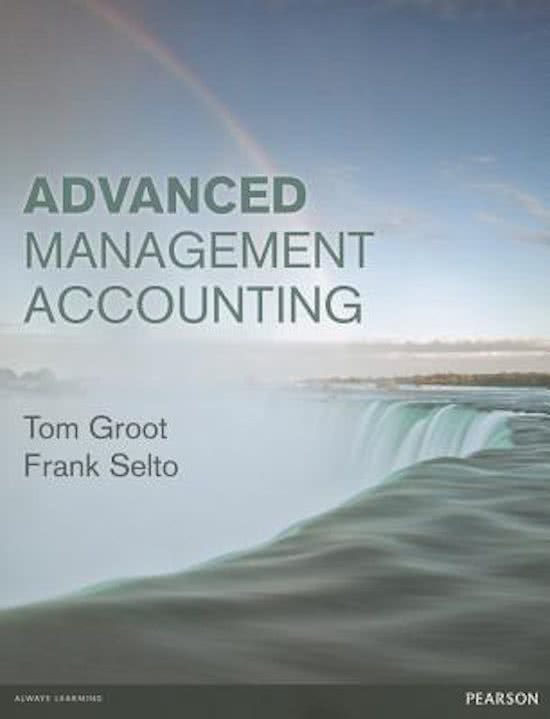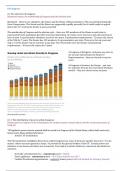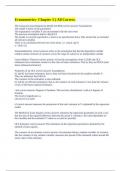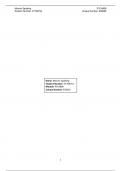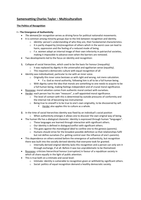Chapter 1 Foundations of Management Accounting ....................................................... 5
1.1. The role of Management Accounting Information .......................................................................................... 5
1.2. Early developments in trade and production ..................................................................................................... 5
1.2.1. Merchants and artisans (Kooplieden en ambachtslieden)........................................................................ 5
1.2.3. The small-sized, functionally unspecialized firm .......................................................................................... 6
1.2.3. The large-scale, functionally specialized firm ............................................................................................... 6
1.3. Increasing complexity of operations..................................................................................................................... 7
1.3.1. The vertically-integrated firm ............................................................................................................................... 7
1.3.2. The multidivisional firm .......................................................................................................................................... 8
1.3.3. Twentieth’s century developments in Management Accounting............................................................. 9
1.3.4. Drivers of Management Accounting Practice ..............................................................................................10
1.4. Management Accounting Theory ........................................................................................................................ 10
1.4.1. Dominance of Financial Accounting Thought .............................................................................................10
1.4.2. In search of accounting information that is relevant for managers ...................................................11
1.4.3. Analytic approaches of decision problems ....................................................................................................12
1.4.4. Management control ...............................................................................................................................................12
1.5. Conclusion .................................................................................................................................................................. 13
Chapter 2: Panning and Decision Making ..................................................................... 14
2.1. Decision making ....................................................................................................................................................... 14
2.1.1. Information and the individual ...........................................................................................................................14
2.1.2. Models of Decision Making behaviour ...........................................................................................................14
2.1.3. Decision making pratices in organizations ...................................................................................................15
2.2. Decision making under risk and uncertainty ................................................................................................... 15
2.2.1. Conditions of certainty: the use of deterministic CVP models..............................................................15
2.2.2. Stochastic models: the introduction of risk ...................................................................................................16
2.2.3. Stochastic models: some extensions .................................................................................................................16
2.2.4. Making decisions under uncertainty ................................................................................................................17
2.2.5. Expected value of additional information ......................................................................................................18
2.3. Decision making under complete uncertainty ................................................................................................. 20
2.3.1. The role of information ..........................................................................................................................................20
2.3.2. Maxi-max and maxi-min utility rule .................................................................................................................21
2.4. Risk, uncertainty and the decision maker ......................................................................................................... 22
2.4.1. The appreciation of risk ........................................................................................................................................22
Chapter 4 – Financial Modeling .................................................................................... 22
Introduction......................................................................................................................................................................... 22
Management Issue ................................................................................................................................................................22
Overview...................................................................................................................................................................................22
Models for Business Decision Making ...................................................................................................................... 23
Profit-Planning Models......................................................................................................................................................23
Cost Behavior .........................................................................................................................................................................23
Basic CVP Model: Breakeven and Target Profit ....................................................................................................24
Target Costing .......................................................................................................................................................................24
Alternative Cost and Revenue Drivers.........................................................................................................................25
Modeling Pro-forma Financial Statement .................................................................................................................26
Financial Ratio Analyses ...................................................................................................................................................26
Modeling Risk and Uncertainty ................................................................................................................................... 26
Modeling Financial Risk....................................................................................................................................................27
Sensitivity Analysis ...............................................................................................................................................................27
Scenario Analysis..................................................................................................................................................................28
, Monte Carlo Analysis .........................................................................................................................................................28
Re-cap of Financial Modeling ...................................................................................................................................... 29
Chapter 5 Budgeting and Beyond .................................................................................. 29
Introduction......................................................................................................................................................................... 29
Budgeting as a Planning Device ....................................................................................................................................30
Budgeting as a Management Control Device ...........................................................................................................30
Different Approaches to Budgeting ............................................................................................................................ 31
Common Budgeting Problems .........................................................................................................................................31
Alternative Remedies for Budgeting Problems.........................................................................................................32
Beyond Budgeting.................................................................................................................................................................33
Activity-Based Budgeting ..................................................................................................................................................34
Activity-Based Budgeting Application ...................................................................................................................... 36
Sales Forecasting..................................................................................................................................................................37
Methods for Sales Forecasting........................................................................................................................................38
Forecasting Sales from Historical Data .....................................................................................................................38
Assessing the Accuracy and Variability of Sales Forecasts................................................................................39
Sales Forecasting and Activity-Based Budgeting Example ................................................................................39
Activity-Based Production Budgets...............................................................................................................................40
Product Margin Budget......................................................................................................................................................41
Capacity Cost Budget and Statement of Income, pro forma ...............................................................................42
Monte Carlo Budget Simulations................................................................................................................................. 44
The Hazardous Game of Aggregating Budgets ....................................................................................................... 45
Budget-Variance Analysis ............................................................................................................................................. 48
Activity-Based Budget Variance Framework ............................................................................................................49
Computation of ABB Variances ......................................................................................................................................50
The Future of Budgeting................................................................................................................................................. 53
Chapter 6 Cost Analysis and Estimation ....................................................................... 53
6.1. Introduction ................................................................................................................................................................ 53
6.2. Cost functions ............................................................................................................................................................ 54
6.2.1. Choice of cost drivers.............................................................................................................................................54
6.2.2. Functional form ........................................................................................................................................................55
6.3. Cost estimation techniques .................................................................................................................................... 56
6.3.1. Cost-benefit concerns .............................................................................................................................................56
6.3.2. Account classification method ............................................................................................................................57
6.3.3. Engineering method ................................................................................................................................................60
6.3.4. High-low method ......................................................................................................................................................60
6.4. Simple Linear Regression ...................................................................................................................................... 62
6.4.1. Introduction ................................................................................................................................................................62
6.4.2. The Basic Linear Regression Model ................................................................................................................62
6.4.3. Assessing the goodness of fit of a regression equation ............................................................................65
6.4.4. Assessing the confidence of a regression equation ....................................................................................67
6.4.5. Specification tests.....................................................................................................................................................67
6.5. Multivariate regression ........................................................................................................................................... 70
6.5.1. Multiple independent variables ..........................................................................................................................70
6.5.2. Indicator variables ..................................................................................................................................................72
6.6. Modeling for Learning ............................................................................................................................................ 74
6.6.1. The basic economics of organizations............................................................................................................ 74
6.6.2. Using the Learning Curve for Cost Estimation ...........................................................................................74
6.6.3. Basic forms and estimation techniques ...........................................................................................................75
6.6.4. Estimating learning models using OLSregression .....................................................................................78
6.6.5. Learning in practice ...............................................................................................................................................79
6.7. Data requirements ................................................................................................................................................. 80
,Chapter 8 Management of Operational Performance ................................................... 81
8.1. Introduction ................................................................................................................................................................ 81
8.1.1. Operational Management .....................................................................................................................................81
8.2. Defining the Production Plan................................................................................................................................ 82
8.2.1. Use of installed capacity .......................................................................................................................................82
8.2.2. The basic LP model .................................................................................................................................................83
8.3. Extensions of LP models........................................................................................................................................ 89
8.3.1 Sequential dependencies.........................................................................................................................................89
8.4. Theory of Constraints .............................................................................................................................................. 91
8.4.1. Basic idea ....................................................................................................................................................................91
8.4.2. TOC and Accounting Measures .........................................................................................................................91
8.5. Quality control........................................................................................................................................................... 94
8.5.1. Quality Economics...................................................................................................................................................94
8.5.2. Total Quality Management ..................................................................................................................................97
8.5.3. Principles of Total Quality ...................................................................................................................................97
8.5.4. Six Sigma .....................................................................................................................................................................97
8.6. Supply Chain Management ................................................................................................................................ 100
Chapter 10 Integrated Financial and Non-Financial Measures ................................. 101
10.1. Introduction ........................................................................................................................................................... 101
10.1.1. Market developments ........................................................................................................................................ 101
10.1.2. Management accounting information in highly competitive industries ....................................... 103
10.1.3. Choosing the right set of performance measures .................................................................................. 104
10.2. Integrated Performance Measurement Systems (IPMS) ......................................................................... 105
10.1.1. The Balanced Scorecard.................................................................................................................................. 105
10.1.2. The Tableau de Bord ......................................................................................................................................... 110
10.1.3. The Performance Pyramid.............................................................................................................................. 111
10.3. IPMS design decisions ...................................................................................................................................... 113
10.1.1. Modeling causal relations for improved decision making ................................................................ 113
10.1.2. Choosing performance measures for control ......................................................................................... 115
10.4. Integrated Performance Measurement Systems (IPMS) in action ............................................... 118
10.1.1. Antecedents for the use of IPMS .................................................................................................................. 118
10.1.2. IPMS purpose of use .......................................................................................................................................... 119
10.1.3. IPMS and performance evaluation ............................................................................................................ 120
Chapter 12 Incentive Systems in Organizations ........................................................ 123
Introduction...................................................................................................................................................................... 123
Management Control and Organizational Goals ................................................................................................. 123
Organizational Setting..................................................................................................................................................... 124
Organizational Outcomes .............................................................................................................................................. 125
Organization Goals and Objectives .......................................................................................................................... 126
Private, Profit-Seeking Firms ....................................................................................................................................... 126
Public and Nonprofit Organizations ......................................................................................................................... 127
Objectives.............................................................................................................................................................................. 127
Organization Structure ................................................................................................................................................. 128
Decentralized Controllability v. Informativeness ................................................................................................ 128
Individual v. Group ........................................................................................................................................................... 129
Models of Motivation ................................................................................................................................................... 130
Intrinsic and extrinsic rewards .................................................................................................................................... 130
Economic model of individual motivation ............................................................................................................... 131
Psychological models of individual motivation ............................................................................................... 132
Attribution theory............................................................................................................................................................... 133
Organizational Justice Theory ..................................................................................................................................... 134
Expectancy theory ............................................................................................................................................................. 134
, Summary of motivational theories .............................................................................................................................. 135
Incentive Systems Design ........................................................................................................................................... 136
Performance targets ......................................................................................................................................................... 137
Performance measures .................................................................................................................................................... 138
Incentives............................................................................................................................................................................... 140
Summary ........................................................................................................................................................................... 141
,Chapter 1 Foundations of Management Accounting
1.1. The role of Management Accounting Information
Management Accounting is concerned with the generation, communication and use of
financial and nonfinancial information for managerial decision making and control activities.
Management accounting information can take many forms, like accounting information
derived directly from the accounting system, financial information taken from external
financial data sources, quantitative information from production departments or qualitative
information from human resource or customer satisfaction enquiries.
Companies using more adequate management accounting information may reach better
decisions and may also more effectively motivate and control their units and employees.
Most of our current Management Accounting systems and techniques have been developed in
practice. Managers developed each of the new planning and control techniques to solve
specific challenges.
As this chapter will show, we can distinguish three main reasons why new management
accounting techniques are developed.
First, a major driver of management accounting development is the way economic activity is
organized. Managers active in fully transparent and efficient markets appear to rely more on
market information and price signals. When markets become less efficient, firms try to
integrate business functions and replace market price information by internal information
about resource consumption that mimic and partly replace price information.
A second major driver of management accounting developments is the way organizations
are structured. Fully centralized organizations require a different internal management
accounting systems than decentralized organizations. Similarly, specialized firms require
different management accounting information compared to diversified corporations. And
third, the type of productive activities performed in organizations may lead to differences
in management accounting information used.
Reconstructing the reason why specific management accounting practices have been
developed may also allow us to pose the same questions again, when reconsidering the needs
of contemporary business organizations. Management accounting solutions that worked well
for past problems may not be necessarily the best solution for current problems, and we can
expect new solutions to evolve.
1.2. Early developments in trade and production
1.2.1. Merchants and artisans (Kooplieden en ambachtslieden)
It is generally believed that the market economy as we know it today originated among
Mediterranean and Baltic societies around 1000 A.D. Independent institutions for
production and trade were allowed to accumulate private property, thus incentivizing
individuals to search for productive opportunities. The information that guided market
exchanges was provided by market prices. Prices also led to the development of extensive
trading networks. Traders active in these networks used market prices to search for and select
economic opportunities. However, they rarely used currencies, but they used elaborate
claims and counterclaims to settle their transactions. These claims were registered in
double-entry accounts, which facilitated the exact registration of what was owing and owed.
This seems to have been the main purpose of double-entry accounting systems in those days
,(Johnson, 1983).1 Most transactions were market transactions between merchant-
entrepreneurs and self-employed artisans. This changed when individuals discovered large
profit opportunities, provided by an increase in market demand for textiles in Western
Europe in the early eighteenth century (Landes, 1969). However, when merchants tried to
substantially increase supply, they discovered that this was costly and inconvenient. An
option was to contract more artisans, but this required more travelling to supervise
more workers. An alternative was to offer higher prices, but this approach frequently
motivated artisans to relax more and produce less. A viable alternative for the
decentralized putting-out, piece- rate contract that allowed each artisan to decide
independently how much he would produce, is to replace this contract by a wage contract.
Merchants thus became employers, gaining control over the artisans‟ productive activities
by administering their production tasks (Johnson, 1983).
1.2.3. The small-sized, functionally unspecialized firm
The merchant-employers, who replaced the market-based contracts with their suppliers by
labour contracts, organized productive activities in centralized work places specialized in
mainly one activity, that of transforming raw materials into finished products. They relied
on wholesale suppliers for the provision of raw materials and commissioned merchants for
selling finished goods to customers. In this system, the impersonal forces of supply and
demand governed the flow of inputs to the factories and the flow of goods from the factory to
customers. (Chandler, 1966b, 1977). While merchant-employers solved the productivity
problem with the individual artisan by placing him in an organization and by offering a wage
contract instead of a transaction contract, they also encountered a new problem. The market-
determined piece-rate prices they previously used for evaluating productivity were no longer
provided within the firm. Employers needed to replicate this information by using cost
accounting information about labor and other conversion costs (Direct labor +
Manufacturing Overhead) per unit of output for each worker and every process in the
firm. It is commonly viewed that this information anticipated management accounting
information as we know it today (Johnson, 1981). The “invisible hand” of market forces
steering decision making of merchants was gradually being replaced by the “visible hand” of
cost accounting information guiding the internal planning and coordination decisions of
merchant-employers. The new cost accounting information was not only used to evaluate
workers’ productivity, but also for steering the search for better production technologies
and for the definition of property claims of different stakeholder groups from increased
productivity.
1.2.3. The large-scale, functionally specialized firm
Companies in the 1800s grew both in size and in geographic dispersion. This was especially
true for railroad companies since 1850 and companies in steel, chemical, and metal
working industries since 1870. These companies used complex production processes, which
were organized in functionally specialized organizational forms. At the same time, these
organizations grew in size and operated in oligopolistic markets. All these conditions required
reliable cost data to manage business processes from a remote corporate unit, to evaluate
unit performance, and to determine final products’ selling prices (Chandler, 1966b). The
earliest factory cost records known to historians are from integrated, multi-process textile
mills, like Charlton Mills (England around 1800), Boston Manufacturing Company (US,
1820s) and Lyman Mills (New England, established around 1855).
Railroad companies were the first organizations with a wide geographic dispersion: most
organizational units were located at a large distance from each other and from headquarters.
,Management needed more summary financial information about subunits‟ performance in
measures like cost per ton-mile and the operating ratio, which equalled the operating income
divided by sales (Kaplan, 1984). The industrial revolution in the mid 1800s led to the rise of
mass production and distribution companies, adapting the US railroads‟ cost accounting
systems to their own needs. Many companies in this era introduced production processes that
were increasingly capital intensive. This development however did not immediately motivate
entrepreneurs to use their accounting systems to account for long-lived (fixed) assets. Most of
them gave only slight attention to asset depreciation or to full-absorption product costing.
The Scientific Management Movement advocated (bepeild) this approach to the optimization
of production processes, which was particularly powerful between 1880 and 1914. It provided
a major impetus (impuls) to the development of cost accounting practices by improving
standard cost accounting calculations. Standard costing techniques defined the allowed
amount of labor and materials required for a unit of output, and were used for setting
operational budgets. Variance analysis was developed to monitor and evaluate variances
between standard and actual costs. Both systems in combination were used to improve
efficiency and to manage reward systems that pay workers on a piece-rate basis (Epstein,
1978). The Scientific Management Movement also led to a new form of organization in which
the traditional line functions were supplemented by staff functions. They were designed not
to accomplish work, but to set standards and ideals, so that the line may work more
efficiently. Consequently, the Scientific Management Movement also caused organizations to
develop ways to measure and allocate overhead costs to products (Kaplan, 1984). These
ideas were not introduced in firms overnight but it appears that the acceptance of Scientific
Management ideas as well as the design of appropriate management and accounting systems
th
have taken quite some time in the first half of the 20 century to be widely adopted and used
by American companies (Fleischman & Tyson, 2007)
1.3. Increasing complexity of operations
1.3.1. The vertically-integrated firm
During the merger wave of 1897-1903, large firms integrated backward with suppliers and
forward with distributors and thus combined their production activities with new activities
such as purchasing, marketing, and transportation. The integrated companies now
controlled internally many transactions across the value chain that had been mediated in the
past by market exchanges (Chandler, 1977).
The more complex US integrated organizations also needed a new organizational structure to
control their diverse set of activities. Most organizations changed to the unitary form of
organization, which is comprised of independent units and one central office to manage both
the units and the entire firm (Chandler, 1966a).
Traditional management accounting information like product-level conversion costs and sales
turnover did not suffice (volstaan) in the more complex organizations and were supplemented
by budgeting information for the entire enterprise, as well as for each of its constituent units.
These budgets expressed the corporate financial objectives and defined each department‟s
required contribution to the firm‟s total financial performance. Common denominators to
measure and compare the inherently very different department‟s contributions to the success
of the entire company were Cash Flow (expressed in cash budgets) and Return on
Investment.
, The DuPont accounting system supported two central management functions: planning (the
allocation of investments, including working capital, and financing new capital requirements)
and control (coordination and management of the horizontal flow of operations). The
investment decisions were guided by the principle that the expenditures for additions to the
earning equipment should be applied to those activities that generate the most additional value
to the company (Johnson, 1975). The criterion used to evaluate investment projects was
Return on Investment: net earnings (minus depreciation and before deduction of interest on
long-term debt) divided by net assets (total assets minus goodwill and other intangibles,
current liabilities, and reserves for depreciation).
Pierre du Pont opposed the then widely-used measure of profits or earnings as a percentage of
sales or costs (as was illustrated by the Carnegie Steel Company). In his view, the ultimate
test is not the percentage of profit on cost, but the rate of return on the money invested in the
business. In order to calculate the denominator, DuPont made a complete record of
investment in plant and equipment in an asset accounting system. This was a major
innovation, sharply contrasting with the conservative accounting practice around 1903, which
stimulated charging-off capital expenditures to retained earnings as quickly as possible
(Johnson, 1972). It took until about 1912 when one of DuPont‟s financial officers, Donaldson
Brown, decomposed the ROI measure further into the product of the sales turnover ratio
(sales divided by total investment) and the operating ratio (earnings to sales) and further
down into other elementary components. This disaggregation was helpful in detecting the
reasons for ROI outcomes to deviate from ROI targets in a given period. The second planning
issue was the financing decision. A general rule was not to use debt financing: all investments
were financed out of retained earnings and sales of company shares. The projection of future
net earnings was thus used to determine the maximum amount of funds available for future
investments. Total net earnings were projected by multiplying the quantity of explosives to be
sold by the estimated net profit per unit for each product, added to the non-operating income
from land sales and earnings from financial investments. Comparing this number with the
investment appropriations lead to the projection of the firm‟s cash position and thus to the
estimation of additional financing needed (Chandler & Salsbury, 1971).
1.3.2. The multidivisional firm
After World War I, some larger companies started to diversify their activities, mostly in an
attempt to capture economies of scope and to diversify business risks. However,
diversification also introduced new management problems.
When GM encountered a great crisis in 1920 (which was known as the “inventory crisis”) the
chairman of the board Pierre Du Pont decided to replace Durant as company president and
asked Alfred P. Sloan to work with him in restructuring the firm. They invited Donaldson
Brown, the architect of the DuPont management accounting system, to join their team as
chief financial officer. The new team installed a new management system that aimed at
accomplishing “centralized control with decentralized responsibility.” This new approach
differs greatly from the management systems used in integrated firms in that it decentralized
operational decision making and control, while at the same time it centralized corporate
strategy making and firm-wide coordination of diversified units.
Each division prepared an annual Price Study in which division managers proposed
a) selling prices for their products, based on sales estimates for the coming year in units and in
dollars, costs, profits,
b) capital requirements, and

